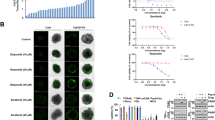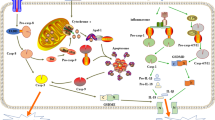Abstract
The aspartic protease cathepsin D (cath-D) is a key mediator of induced-apoptosis and its proteolytic activity has been generally involved in this event. During apoptosis, cath-D is translocated to the cytosol. Because cath-D is one of the lysosomal enzymes that requires a more acidic pH to be proteolytically active relative to the cysteine lysosomal enzymes such as cath-B and -L, it is therefore open to question whether cytosolic cath-D might be able to cleave substrate(s) implicated in the apoptotic cascade. Here, we have investigated the role of wild-type cath-D and its proteolytically inactive counterpart overexpressed by 3Y1-Ad12 cancer cells during chemotherapeutic-induced cytotoxicity and apoptosis, as well as the relevance of cath-D catalytic function. We demonstrate that wild-type or mutated catalytically inactive cath-D strongly enhances chemo-sensitivity and apoptotic response to etoposide. Both wild-type and mutated inactive cath-D are translocated to the cytosol, increasing the release of cytochrome c, the activation of caspases-9 and -3 and the induction of a caspase-dependent apoptosis. In addition, pretreatment of cells with the aspartic protease inhibitor, pepstatin A, does not prevent apoptosis. Interestingly therefore, the stimulatory effect of cath-D on cell death is independent of its catalytic activity. Overall, our results imply that cytosolic cath-D stimulates apoptotic pathways by interacting with a member of the apoptotic machinery rather than by cleaving specific substrate(s).
This is a preview of subscription content, access via your institution
Access options
Subscribe to this journal
Receive 50 print issues and online access
$259.00 per year
only $5.18 per issue
Buy this article
- Purchase on Springer Link
- Instant access to full article PDF
Prices may be subject to local taxes which are calculated during checkout





Similar content being viewed by others
References
Berchem G, Glondu M, Gleizes M, Brouillet JP, Vignon F, Garcia M et al. (2002). Oncogene 21: 5951–5955.
Bidère N, Lorenzo HK, Carmona S, Laforge M, Harper F, Dumont C et al. (2003). J Biol Chem 278: 31401–31411.
Capony F, Morisset M, Barrett AJ, Capony JP, Broquet P, Vignon F et al. (1987). J Cell Biol 104: 253–262.
Cirman T, Oresic K, Mazovec GD, Turk V, Reed JC, Myers RM et al. (2004). J Biol Chem 279: 3578–3587.
Deiss LP, Galinka H, Berissi H, Cohen O, Kimchi A . (1996). EMBO J 15: 3861–3870.
Demoz M, Castino R, Cesaro P, Baccino FM, Bonelli G, Isidoro C . (2002). Biol Chem 383: 1237–1248.
Emert-Sedlak L, Shangary S, Rabinovitz A, Miranda MB, Delach SM, Johnson DE . (2005). Mol Cancer Ther 4: 733–742.
Ferrandina G, Scambia G, Bardelli F, Benedetti Panici P, Mancuso S, Messori A . (1997). British J Cancer 76: 661–666.
Foekens JA, Look MP, Bolt-de Vries J, Meijer-van Gelder ME, van Putten WL, Klijn JG . (1999). British J Cancer 79: 300–307.
Garcia M, Derocq D, Pujol P, Rochefort H . (1990). Oncogene 5: 1809–1814.
Glondu M, Coopman P, Laurent-Matha V, Garcia M, Rochefort H, Liaudet-Coopman E . (2001). Oncogene 20: 6920–6929.
Glondu M, Liaudet-Coopman E, Derocq D, Platet N, Rochefort H, Garcia M . (2002). Oncogene 21: 5127–5134.
Gottlieb RA, Nordberg J, Skowronski E, Babior BM . (1996). Proc Natl Acad Sci USA 93: 654–658.
Heinrich M, Neumeyer J, Jakob M, Hallas C, Tchikov V, Winoto-Morbach S et al. (2004). Cell Death Differ 11: 550–563.
Johansson AC, Steen H, Öllinger K, Roberg K . (2003). Cell Death Differ 10: 1253–1259.
Kagedal K, Johansson U, Öllinger K . (2001). FASEB J 15: 1592–1594.
Koike M, Nakanishi H, Saftig P, Ezaki J, Isahara K, Ohsawa Y et al. (2000). J Neurosci 20: 6898–6906.
Koike M, Shibata M, Ohsawa Y, Nakanishi H, Koga T, Kametaka S et al. (2003). Mol Cell Neurosci 22: 146–161.
Laurent-Matha V, Maruani-Herrmann S, Prebois C, Beaujouin M, Glondu M, Noel A et al. (2005). J Cell Biol 168: 489–499.
Liaudet E, Garcia M, Rochefort H . (1994). Oncogene 9: 1145–1154.
Matsuyama S, Llopis J, Deveraux QL, Tsien RY, Reed JC . (2000). Nat Cell Biol 2: 318–325.
Nakanishi H, Zhang J, Koike M, Nishioku T, Okamoto Y, Kominami E et al. (2001). J Neurosci 21: 7526–7533.
Öllinger K . (2000). Arch Biochem Biophys 373: 346–351.
Reiners Jr JJ, Caruso JA, Mathieu P, Chelladurai B, Yin XM, Kessel D . (2002). Cell Death Differ 9: 934–944.
Roberg K . (2001). Lab Invest 81: 149–158.
Roberg K, Kagedal K, Öllinger K . (2002). Am J Pathol 161: 89–96.
Roberg K, Öllinger K . (1998). Am J Pathol 152: 1151–1156.
Rochefort H . (1996). Eur J Cancer 32A: 7–8.
Saftig P, Hetman M, Schmahl W, Weber K, Heine L, Mossmann H et al. (1995). EMBO J 14: 3599–3608.
Sawada M, Nakashima S, Banno Y, Yamakawa H, Hayashi K, Takenaka K et al. (2000). Cell Death Differ 7: 761–772.
Shibata M, Kanamori S, Isahara K, Ohsawa Y, Konishi A, Kametaka S et al. (1998). Biochem Biophys Res Commun 251: 199–203.
Takuma K, Kiriu M, Mori K, Lee E, Enomoto R, Baba A et al. (2003). Neurochem Int 42: 153–159.
Tardy C, Tyynela J, Hasilik A, Levade T, Andrieu-Abadie N . (2003). Cell Death Differ 10: 1090–1100.
Terman A, Neuzil J, Kagedal K, Öllinger K, Brunk UT . (2002). Exp Cell Res 274: 9–15.
Werneburg NW, Guicciardi ME, Bronk SF, Gores GJ . (2002). Am J Physiol Gastrointest Liver Physiol 283: G947–G956.
Westley BR, May FE . (1996). Eur J Cancer 32A: 15–24.
Wu GS, Saftig P, Peters C, El-Deiry WS . (1998). Oncogene 16: 2177–2183.
Acknowledgements
We thank Dr Karin Öllinger (Linköping University, Sweden) for her kind help and valuable discussions concerning the digitonin method, Jean-Yves Cance for the photographs, Nicole Lautredou-Audouy (Centre de Ressources en Imagerie Cellulaire) for confocal microscopy and Nadia Kerdjadj for her secretarial assistance. This work was supported by Institut National de la Santé et de la Recherche Médicale, University of Montpellier I, Association pour la Recherche sur le Cancer (Grant 3344, E Liaudet-Coopman and Grant 3118, S Baghdiguian), Ligue Nationale contre le Cancer who provided a fellowship for Mélanie Beaujouin, and Ministère de la Culture, de l’Enseignement Supérieur et de la Recherche du Luxembourg who provided a fellowship for Dr Murielle Glondu-Lassis.
Author information
Authors and Affiliations
Corresponding author
Rights and permissions
About this article
Cite this article
Beaujouin, M., Baghdiguian, S., Glondu-Lassis, M. et al. Overexpression of both catalytically active and -inactive cathepsin D by cancer cells enhances apoptosis-dependent chemo-sensitivity. Oncogene 25, 1967–1973 (2006). https://doi.org/10.1038/sj.onc.1209221
Received:
Revised:
Accepted:
Published:
Issue Date:
DOI: https://doi.org/10.1038/sj.onc.1209221
Keywords
This article is cited by
-
Cathepsin D as a potential therapeutic target to enhance anticancer drug-induced apoptosis via RNF183-mediated destabilization of Bcl-xL in cancer cells
Cell Death & Disease (2022)
-
Role of lysosomes in physiological activities, diseases, and therapy
Journal of Hematology & Oncology (2021)
-
Lysosomal Hydrolase Cathepsin D Non-proteolytically Modulates Dendritic Morphology in Drosophila
Neuroscience Bulletin (2020)
-
Enzymatically active cathepsin D sensitizes breast carcinoma cells to TRAIL
Tumor Biology (2016)
-
Haematopoietic development and immunological function in the absence of cathepsin D
BMC Immunology (2007)



